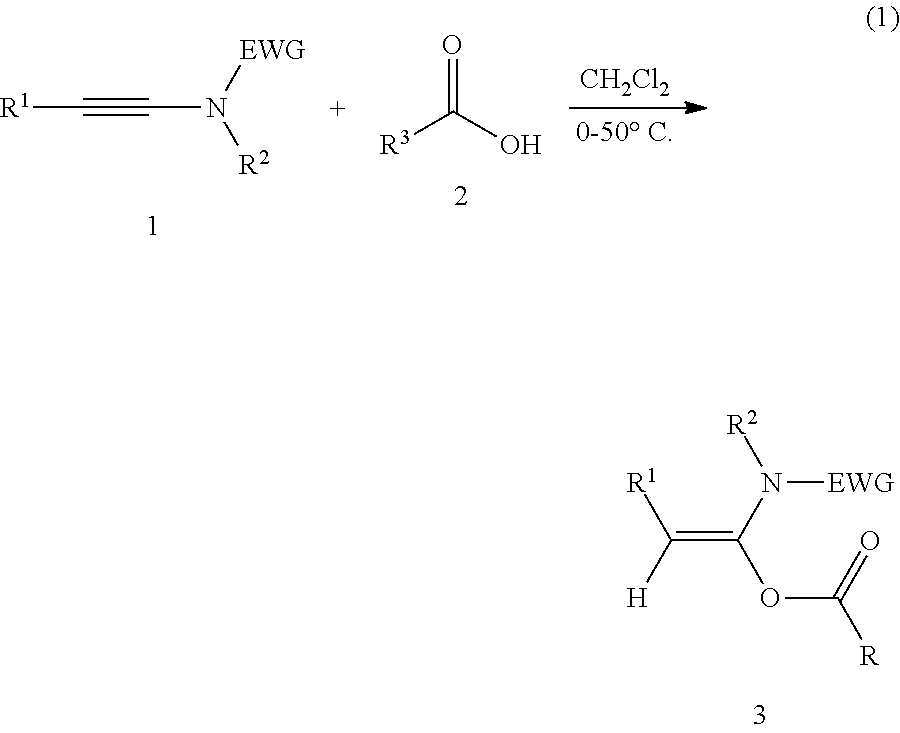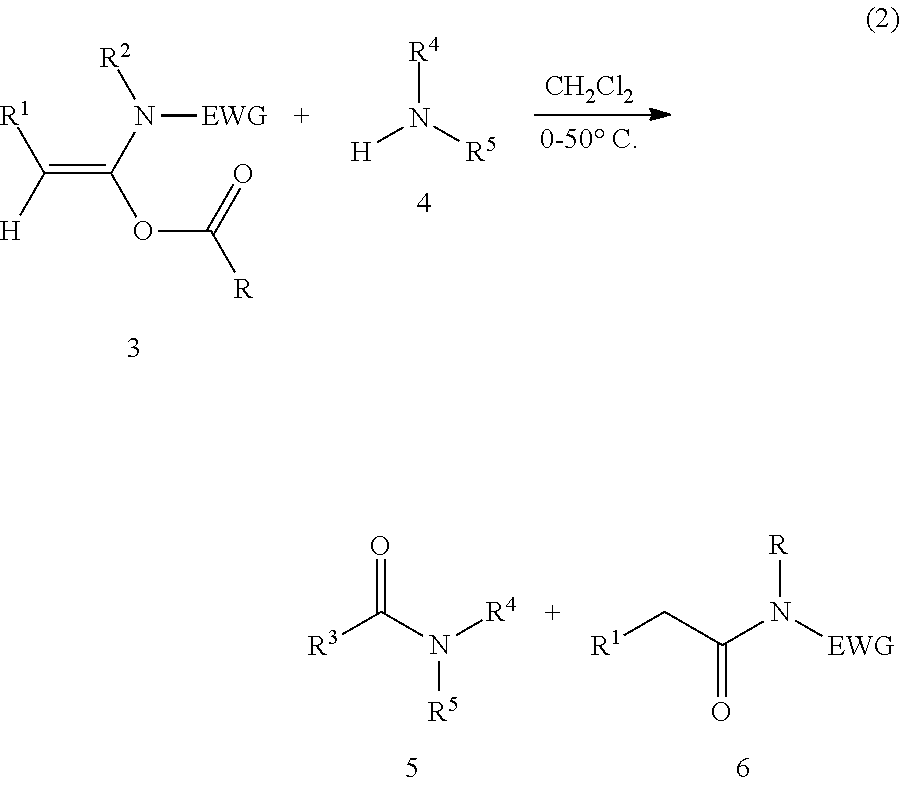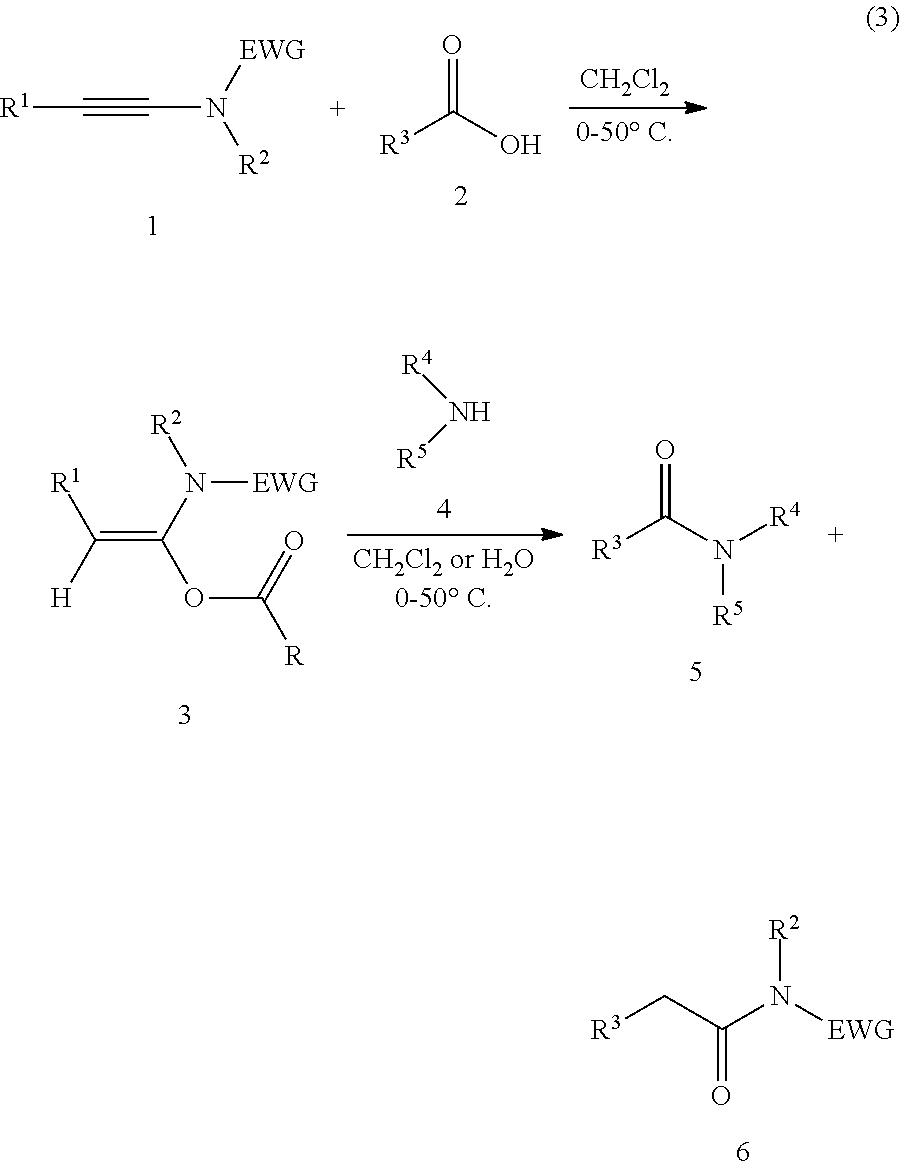Mild and efficient preparation method for a-acyloxyenamide compounds and use thereof in synthesis of amide and polypeptide
a technology of acyloxyenamide and acyloxyenamide, which is applied in the field of preparation of acyloxyenamide compounds, can solve the problems of low coupling efficiency, easy racemization, and seemingly simple reaction not so easy to execute, and achieves a mild and direct and concise effect, more concise and efficient, and better reach of potential applications
- Summary
- Abstract
- Description
- Claims
- Application Information
AI Technical Summary
Benefits of technology
Problems solved by technology
Method used
Image
Examples
embodiment 1
[0039]N-methyl-N-ethynyl p-toluenesulfonamide (0.20 mmol) and formic acid (2 mmol) are added to a clean 25 mL reaction tube, and an appropriate amount of dichloromethane is added as a solvent. The reaction is carried out at 10° C. for 10 minutes. TLC analysis is then performed. After the completion of the reaction, the solvent was concentrated off and the column chromatography are carried out to obtain a pure product, white solid, with a yield of 99%. The following are the structural formula of the product and the NMR data and mass spectrometry data of the product:
[0040]1H NMR (400 MHz, CDCl3) δ 8.06 (s, 1H), 7.71 (d, J=8.3 Hz, 2H), 7.33 (t, J=7.5 Hz, 3H), 4.83 (d, J=2.9 Hz, 1H), 4.73 (d, J=2.8 Hz, 1H), 3.01 (s, 3H), 2.43 (s, 3H).
[0041]13C NMR (100 MHz, CDCl3) δ 158.2, 146.9, 144.4, 134.1, 129.6, 127.8, 99.7, 36.8, 21.5 ppm.
[0042]HRMS m / z (ESI) calcd for C11H14NO4S (M+H)+: 256.0644, found: 256.0647.
embodiment 2
[0043]N-methyl-N-ethynyl p-toluenesulfonamide (0.20 mmol) and adamantanecarboxylic acid (0.3 mmol) are added to a clean 25 mL reaction tube, and an appropriate amount of dichloromethane is added as a solvent. The reaction is carried out at 0° C. for 4 hours. TLC analysis is then performed. After the completion of the reaction, the solvent was concentrated off and the column chromatography are carried out to obtain a pure product, white solid, with a yield of 99%. The following are the structural formula of the product and the NMR data and mass spectrometry data of the product:
[0044]1H NMR (400 MHz, CDCl3) δ 7.73 (d, J=8.3 Hz, 2H), 7.32 (d, J=8.1 Hz, 2H), 4.83 (d, J=2.2 Hz, 1H), 4.79 (d, J=2.2 Hz, 1H), 2.95 (s, 3H), 2.42 (s, 3H), 1.97 (s, 3H), 1.75 (d, J=2.5 Hz, 6H), 1.70 (d, J=12.4 Hz, 3H), 1.63 (d, J=12.1 Hz, 3H).
[0045]13C NMR (100 MHz, CDCl3) δ 174.8, 146.5, 143.9, 134.1, 129.5, 128.1, 102.0, 41.0, 38.3, 36.6, 36.2, 27.7, 21.5 ppm.
[0046]HRMS m / z (ESI) calcd for C21H28NO4S (M+H)+: ...
embodiment 3
[0047]N-methyl-N-ethynyl p-toluenesulfonamide (0.30 mmol) and parachlorobenzoic-acid (0.2 mmol) are added to a clean 25 mL reaction tube, and an appropriate amount of dichloromethane is added as a solvent. The reaction is carried out at room temperature for κ hours. TLC analysis is then performed. After the completion of the reaction, the solvent was concentrated off and the column chromatography are carried out to obtain a pure product, white solid, with a yield of 99%. The following are the structural formula of the product and the NMR data and mass spectrometry data of the product:
[0048]1H NMR (400 MHz, CDCl3) δ 7.83 (d, J=8.6 Hz, 2H), 7.73 (d, J=8.2 Hz, 2H), 7.39 (d, J=8.5 Hz, 2H), 7.27 (d, J=8.1 Hz, 2H), 5.02 (d, J=2.5 Hz, 1H), 4.83 (d, J=2.6 Hz, 1H), 3.10 (s, 3H), 2.40 (s, 3H).
[0049]13C NMR (100 MHz, CDCl3) δ 163.1, 146.9, 144.0, 140.3, 134.1, 131.5, 129.5, 128.8, 127.9, 127.1, 101.4, 37.3, 21.5 ppm.
[0050]HRMS m / z (ESI) calcd for C17H17ClNO4S (M+H)+: 366.0567, found: 366.0563....
PUM
| Property | Measurement | Unit |
|---|---|---|
| temperature | aaaaa | aaaaa |
| molar ratio | aaaaa | aaaaa |
| temperature | aaaaa | aaaaa |
Abstract
Description
Claims
Application Information
 Login to View More
Login to View More - R&D
- Intellectual Property
- Life Sciences
- Materials
- Tech Scout
- Unparalleled Data Quality
- Higher Quality Content
- 60% Fewer Hallucinations
Browse by: Latest US Patents, China's latest patents, Technical Efficacy Thesaurus, Application Domain, Technology Topic, Popular Technical Reports.
© 2025 PatSnap. All rights reserved.Legal|Privacy policy|Modern Slavery Act Transparency Statement|Sitemap|About US| Contact US: help@patsnap.com



